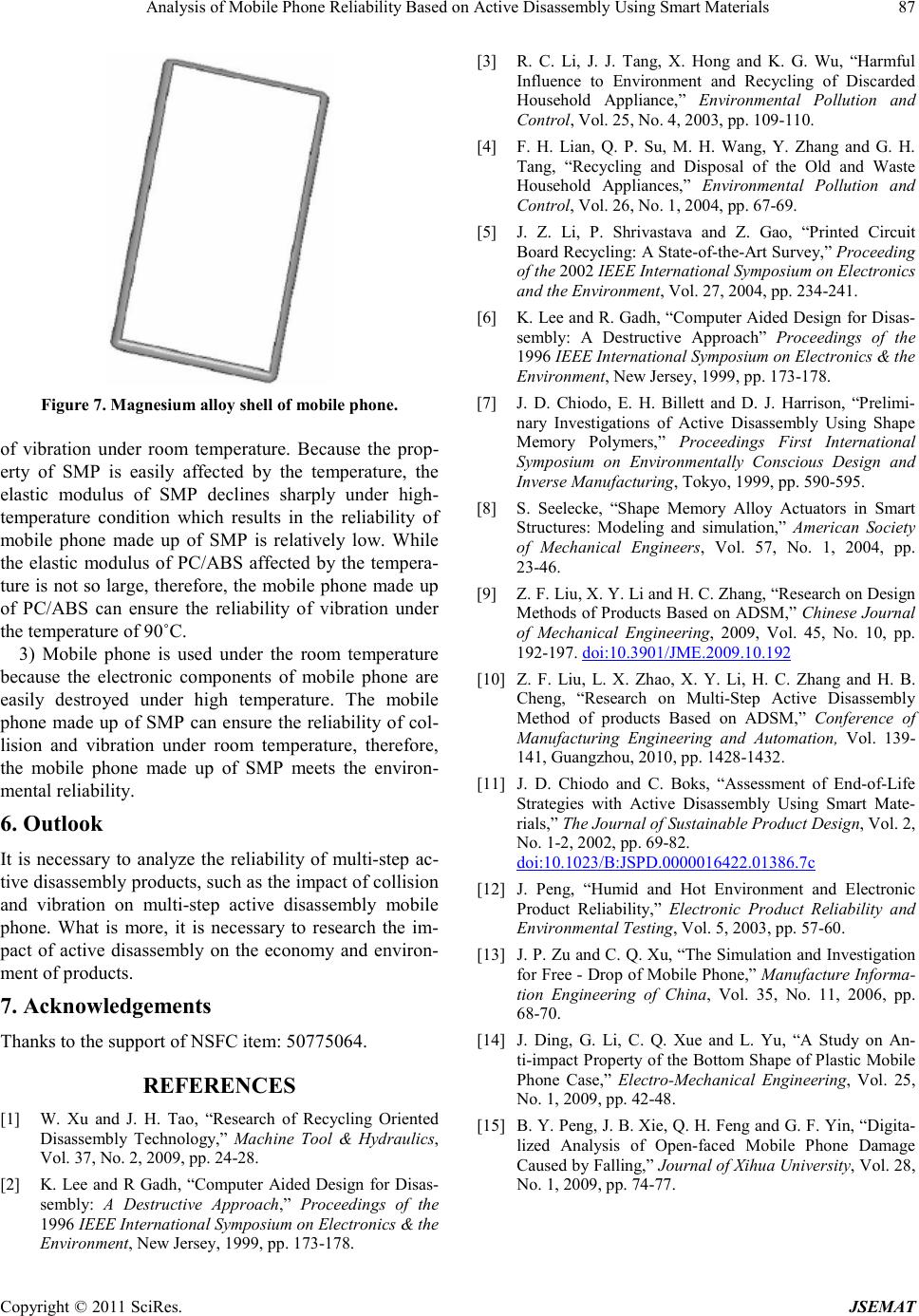
Analysis of Mobile Phone Reliability Based on Active Disassembly Using Smart Materials
Copyright © 2011 SciRes. JSEMAT
Figure 7. Magnesium alloy s hell o f mobi le phone.
of vibration under room temperature. Because the prop-
erty of SMP is easily affected by the temperature, the
elastic modulus of SMP declines sharply under high-
temperature condition which results in the reliability of
mobile phone made up of SMP is relatively low. While
the elastic modulus of PC/ABS affected by the tempera-
ture is not so large, therefore, the mobile phone made up
of PC/ABS can ensure the reliability of vibration under
the temperature of 90˚C.
3) Mobile phone is used under the room temperature
because the electronic components of mobile phone are
easily destroyed under high temperature. The mobile
phone made up of SMP can ensure the reliability of col-
lision and vibration under room temperature, therefore,
the mobile phone made up of SMP meets the environ-
mental reliability.
6. Outlook
It is necessary to analyze the reliability of multi-step ac-
tive disasse mbl y prod ucts, s uch as the i mpact o f collision
and vibration on multi-step active disassembly mobile
phone. What is more, it is necessary to research the im-
pact of active disassembly on the economy and environ-
ment of products.
7. Acknowledgements
Thanks to the suppo rt of NS F C item: 50775064.
REFERENCES
[1] W. Xu and J. H. Tao, “Research of Recycli ng Oriented
Disassembly Technology,” Machine Tool & Hydraulics,
Vol. 37, No. 2, 20 09, pp. 24-28.
[2] K. Lee and R Gadh, “Computer Aided Design for Disas-
sembly: A Destructive Approach,” Proceedings of the
1996 IEEE International Symposium on Electronics & the
Environment, New Jersey, 1999, pp. 173-178.
[3] R. C. Li, J. J. Tang, X. Hong and K. G. Wu, “Harmful
Influence to Environment and Recycling of Discarded
Household Appliance,” Environmental Pollution and
Control, Vol . 25, No. 4, 2003, pp. 109-110.
[4] F. H. Lian, Q. P. Su, M. H. Wang, Y. Zhang and G. H.
Tang, “Recycling and Disposal of the Old and Waste
Household Appliances,” Environmental Pollution and
Control, Vol . 26, No. 1, 2004, pp. 67-69.
[5] J. Z. Li, P. Shrivastava and Z. Gao, “Printed Circuit
Board Recycling: A State-of-the-Art Survey,” Proceeding
of the 2002 IEEE International Symposium on Electronics
and the Env i ronme nt , Vol. 27, 2004, pp. 234-241.
[6] K. Lee and R. Gadh, “Computer Aided Design for Disas-
sembly: A Destructive Approach” Proceedings of the
1996 IEEE International Symposium on Electronics & the
Environment, Ne w Jer s ey , 1999, pp. 173-178.
[7] J. D. Chiodo, E. H. Billett and D. J. Harrison, “Prelimi-
nary Investigations of Active Disassembly Using Shape
Memory Polymers,” Proceedings First International
Symposium on Environmentally Conscious Design and
Inverse Manufacturing, Tokyo, 1999, pp. 590-595.
[8] S. Seelecke, “Shape Memory Alloy Actuators in Smart
Stru ctures: Modeling and simulation,” American Society
of Mechanical Engineers, Vol. 57, No. 1, 2004, pp.
23-46.
[9] Z. F. Liu , X. Y. Li a nd H. C. Zhang, “Research on Desi gn
Methods of Products Based on ADSM,” Chinese Journal
of Mechanical Engineering, 2009, Vol. 45, No. 10, pp.
192-197. doi:10.3901/JME.2009.10.192
[10] Z. F. Liu, L. X. Zhao, X. Y. Li, H. C. Zhang and H. B.
Cheng, “Research on Multi-Step Active Disassembly
Method of products Based on ADSM,” Conference of
Manufacturing Engineering and Automation, Vol. 139-
141, Guangzhou, 2010, pp. 1428-1432.
[11] J. D. Chiodo and C. Boks, “Assessment of End-of-Life
Strategies with Active Disassembly Using Smart Mate-
rials,” The Journal of Sustainable Product Design, Vol. 2,
No. 1-2, 2002, pp. 69-82.
doi:10.1023/B:JSPD.0000016422.01386.7c
[12] J. Peng, “Humid and Hot Environment and Electronic
Product Reliability,” Electronic Product Reliability and
Environmental Testing, Vol. 5, 20 03, pp . 57-60.
[13] J. P. Zu an d C. Q. Xu, “The Si mulation and Investigation
for Free - Drop of Mobile Phone,” Manufacture Informa-
tion Engineering of China, Vol. 35, No. 11, 2006, pp.
68-70.
[14] J. Ding, G. Li, C. Q. Xue and L. Yu, “A Study on An-
ti-impact Property of the Bottom Shape of Plastic Mobile
Phone Case,” Electro-Mechanical Engineering, Vol. 25,
No. 1, 2009, pp. 42-48.
[15] B. Y. Peng, J. B. Xie, Q. H. Feng and G. F. Yin, “Digita-
lized Analysis of Open-faced Mobile Phone Damage
Caused by Falling,” Journal of Xihua University, Vol. 28,
No. 1, 2009, pp. 74-77.